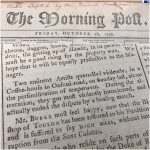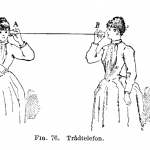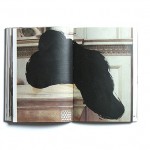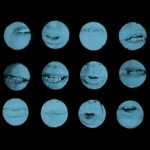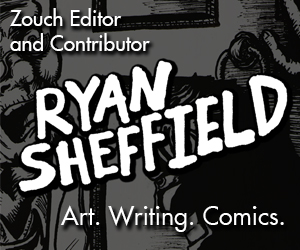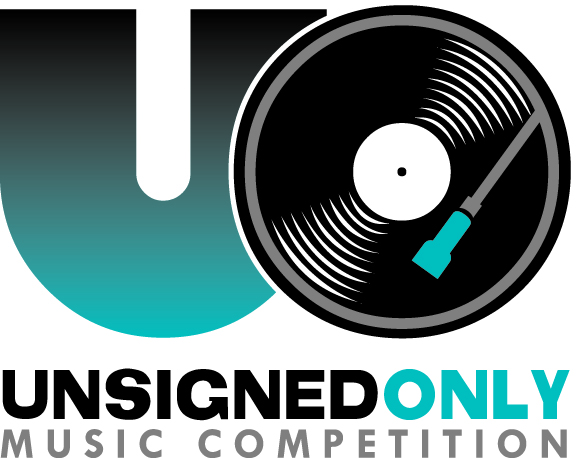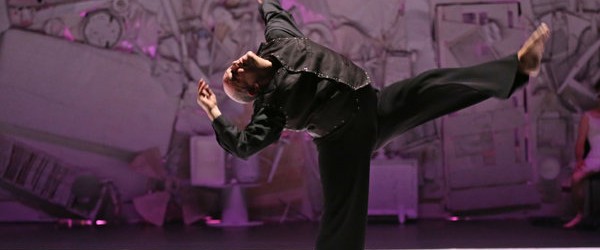
ZOUCH Close-up: {Interview} with David Dorfman
Artists, Entertainers, InterviewsIn celebration of April 29, International Dance Day, Zouch contributor J.M. Hall interviews David Dorfman, of David Dorfman Dance. Dorfman spills all about the beauty of accessible theatre and dance, pushing boundaries of race, and being vulnerable when making art, and dancing.
ZOUCH: What kind of relationships do you perceive among your theatrical performances, your academic teaching, and your community outreach activities? How do see these being connected, if at all?
DAVID: I think they’re really intimately connected. My whole theme is that we all can go beyond ourselves, and be better people towards one another, including toward ourselves. And I think character and performing can do that, can be a door into that, a gateway. And I think that when you’re teaching, to me that is a performance. And I also think that, really, every day of your life is a kind of performance, particularly in this country…And even in countries, sadly, where you don’t have as much freedom, performance can almost be a mode of survival. Like, “How am I gonna’ get through this day?” We went to the Civil Rights Museum—and to think of what our country has done, what it continues to do, in many political and social arenas—how folks can survive that is just unbelievable. And part of it is through, “I can be this person today to get by.” And when we do have the luxury of being, perhaps, metaphorically enslaved, or realistically enslaved, “How can I be a better leader? How can I be a better community member? How can I be a better friend?” And I think it all comes down to figuring out which roles you wanna’ emulate, and performing them…
So if there were a group of advanced dancers that I didn’t know, I’d be just as likely to do a name game as a warm-up, so that I’d actually know who I’m teaching. And I’d see what there predilections were for movement, and I’d talk about symmetry and asymmetry, lines and circles, “bound flow,” “free flow,” whatever. But then, and at Connecticut College we say, “Those that have not yet danced,” as opposed to “non-dancers.” Or, if they’ve been like the pros of the century, they’ve just danced like crazy…But I’m looking for people that want to communicate, through literal and figurative touch, want to be in community situations. Want to build relationships with them, moment to moment, just like you see everyone doing right now [the professional dancers warming up for the rehearsal]. And I don’t want people just listening to headphones as a warm-up. I want it to be more communal; and then we’re living, we’re practicing what we preach all the time. So I guess, on some level, I feel that there’s not a big division between a community class and a “dancer” dance class…
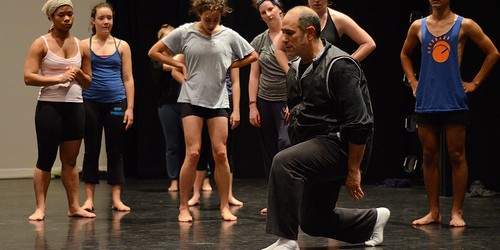
ZOUCH: Could you talk a bit about your inclusion of speaking parts for the dancers, particularly in regard to how that speech manifest from their diverse embodiments and social positions?
DAVID: Part of why I use texts, it’s probably two- or three-fold reasons. One is that I really believe in an accessible theater. And so I find that dance, in its abstraction, at times, can leave people in the dust a bit. And I like to give folks a framework. Some cues, context. So that’s one of the reasons that I use texts, it can be helpful that way. Another reason is that my early admiration more went, in a more formal way, to more experimental theater, in Chicago, where I grew up. I have memories of telling my mom, when I was eight, that I wanted to have a dance studio. So dance has always been this thing that I did and wanted to do. It took me until almost the end of college to even try it in a serious level, but somehow I got more involved, even at the high school level, just watching this incredible experimental theater that had movement in it, but more was just wacky ideas, full of non sequitirs, and risks and chances. And I’d go to Second City a lot, and so that never left me… Many experimental theater companies in New York, sometimes I find their dances more engaging than dance company dances, because it’s meant to serve a theatrical purpose. It’s sometimes offhanded, humorous, candid, off-the-wall. It’s not as concerned with pure technical prowess, but more humanity, and humor…
By the way, you talked about embodiment in this question, and I don’t know if I really got to that. About how the text appears (or presents itself) differently depending on the body that’s enunciating the text? Well, we’ve played a lot with that. There’s one character that’s not in the company any longer, but she was a really good writer, and she really wanted to mess with that. We called it…it wasn’t “race-bender”…I’ll have to think of the name and tell you, Joshua. But we had a nickname for her monologue in “Disavowal.” It was like “race-changer,” or “race-chameleon,” or whatever, because she was kind of saying, “You perceive as white, but I’m black.” That kind of thing. And then we had a black performer saying, “I want white.” So we were really pushing those boundaries…
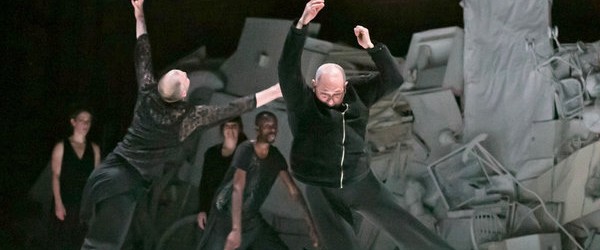
ZOUCH: In what ways do you think being a musician influences your dances? And relatedly, what do you think, of the view espoused, for example, by the African-American novelist Ralph Ellison, that Africana music performance is essentially a kind of dance already?
DAVID: Well, you know, in this piece in particular, my being so exceptionally motivated by Sly and the Family Stone as a kid, working out in my neighbor’s basement, listening to eight-track tapes, and then seeing them my first week of college, and being just kind of blown away by every aspect of their performance: the power of the music, the message of the music, the fact that there was black and white on stage, that there was a woman playing the trumpet, all these different aspects of revolutionary behavior. I was completely, completely, completely taken by James Brown, by his theatricality, his way of moving. I imitated him; I used a baseball bat as a microphone, and as an eight to ten-year-old would try to learn every dance of his. So there’s this idea of where some of that music comes from. We say, “Way back to Africa,” but in a more Americana way, from the church, and from Africa’s influences, and from hurt, and from injustice. And so, whether you wanna’ call it “soul,” or “rhythm and blues,” “the blues,” whatever, it’s not a frivolous expression of, “Maybe I’ll sing today,” but it’s this thing that needs to be said. And that’s why I think that one should make dances, write novels, paint pictures, that are—that these things need to be—in the world.
Also, the Africanist theory is that there really isn’t separation between music and dance. If you learn to drum, you learn to dance; if you learn to dance, you learn to drum. So I think that it’s embodied. I mean, if you look at Sly himself, he’d come out in the audience and do these crazy dances. James brown is a musician and a dancer. Then the current thing, there’s Bruno Mars, there was Michael Jackson, folks that take that seriously. And there’s Caucasian folks that are doing that as well, have done it: the Elvises, whatever. I think that history shows that the Africanist movement is so strong in physicalizing music. So yeah, I do agree with that statement…
ZOUCH: Speaking as a white male who is passionate about social justice—and inspired in part by your dance “Disavowal”—how do you negotiate being the creative authority for dances which address forms of embodiment different than your own, as in “Prophets of Funk”?
DAVID: Part of the reason that I kind of emboldened myself for “Disavowal” was that I was kinda’ hangin’ on, and the whole thing came from the character of John Brown. So, here’s a white guy that really, really wanted to help black folk, wanted to end slavery basically, but had a maniacal personality, and a maniacal way of doing it. And so, it was this flawed character who wanted good, and happened to be white. And my pal, David Kim, religious studies professor and philosopher up at Connecticut College, he’s the one that fed me that idea originally, and for those reasons. I mean, he’s an Asian guy of color. He’s not a black man, but he’s done a lot of work on race, and said, “You know, this might interest you. This is some really interesting stuff.” And of course I knew, from Harper’s Ferry, who John Brown was, but I never thought of doing a dance about it. And so then it just started to take shape, and was really interesting. And the discussions we had, the arguments we had, the fights on stage we had. I mean, it was really heavy, we had to debrief quite a bit after that piece. We’re probably going to, we’ve been hired to do something at Swarthmore [College] about social justice, and although we don’t really have that piece in our current repertory, we’ll probably do lectures on it, maybe do a couple sections and talk about it, which would be great…
And I feel a little bit similarly here. I’m roughly doing this character of a—just, half-reliving my funk past, when I had really tall hair and big platform heels—and also being kinda’ the Jewish manager among the great black stars. Which might be considered a trope, but it really happened. And still does, particularly with Sly. So, just being that kind of person, that, Jewish, (basically) suburban kid, who wears long hair and thinks that black folks are cool, and wants to be Quinn Buckner the basketball player, and James Brown the singer, Sly, you know. And it’s a typical scenario, in a certain way, but also, I like to be vulnerable on stage. I like to be vulnerable in art-making. And so it puts you in a position where you’re rife for criticism, but that doesn’t bother me so much… To me, ultimately, it’s about what’s happening on stage, and the integrity of the artwork. It’s funny, because sometimes you might hear something like, “I love that piece, but I hear the choreographer’s a real jerk.” That can’t not influence, and yet you’re not attending the theater to go have a drink—maybe you are—but most of the time not to go have a drink with the choreographer. You’re mostly coming to see the choreographic work… They don’t need to know who I am. When I come out there, I could just be a character that looks to be older than the rest of the guys, but doesn’t have to be the choreographer. So that’s important, yeah.






